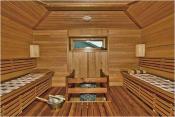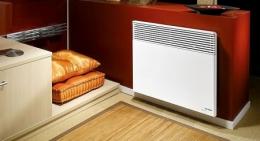Search
Login
Electric convector, electric convector, how to choose
Different sources of heat are used to heat the house or office premises, one of the most comfortable options for humans is electric convectors. You can use them wherever electricity is supplied; they attract with their compactness and rather high efficiency.
Content:
- What is an electric convector video
- Types of electric heating convectors
- Useful tips for choosing video
- Electric heating convectors with thermostat
- Installation and connection of an electric convector video
What is an electric convector
Electric convectors - heating panels that are used to heat a limited area. Despite the fact that the design of the device is straightforward, its work is very productive.

Inside the device is a heater, which generates heat, that is, serves as its source. The device has the form of a tube made of steel, in which a spiral of nichrome thread is located. The thread is insulated with a special ceramic compound. The most important thing in the tube is that it is thoroughly sealed.
The outer side of the convector is a body made decoratively of metal. There are openings on the case: those located at the top serve to let out already heated air, those that are located at the bottom serve to get cold air into the device.

The maximum temperature of the air leaving the convector can reach + 100 degrees C. The maximum temperature is directly related to the power of the installed heater.
This heater is equipped with a frame. Its fasteners can be performed on almost any vertically located surface with the help of several screws. Directly onto it, the convector is mounted. The design is safe and reliable, complies with regulatory standards and fire safety requirements.

A device of this kind does not affect the change in humidity in the room in which it is used. In addition to this, the dust that settles on the heater does not burn. The decorative outer panel does not heat up, so you should not worry about small children who, out of curiosity, can touch it, or animals that decide to warm themselves.
If desired, a sensor can be installed in the convection design. With it, you can control the temperature regime. Devices of this type are reliably protected from moisture penetration. Their installation can be safely planned in rooms with high humidity (bathrooms, showers, saunas and baths). There are also models in which fans are provided. With their help, the air flow spreads evenly and continuously.
Modern manufacturers offer models equipped with thermostats. They help in regulating the heating of the heater.
Thermostats can be of two types: electronic and electromechanical. Structures with mechanics are much cheaper due to the simplicity of equipment. With electronics are more expensive, but they have the adjustment is more accurate.
Electric convectors: expert opinion:
Types of electric heating convectors
There are two main types:
narrow or skirting - whose height is 20 cm
high - whose height is 45 cm.
Types differ not only in size, but also in the heating elements that are installed in them.
baseboard convector
Often, their installation is done under stained glass windows or windows located below normal.
They have low heat transfer, but if desired or necessary, it is increased due to the length of the device (the maximum length can be made about 2.5 meters). This option is suitable for balancing the operation of two types of devices. The power of such convectors is 3 kilowatts.
convector high
This type of wall mounted electronic convector can be placed anywhere suitable for installation. Acceptable option for their use instead of the usual batteries.

By the way, the use of such structures is much more efficient. If desired or necessary, with the help of electric convectors, you can provide heating in your own home. To do this, you need to correctly calculate the power of the necessary heat transfer and purchase the right number of units.
There are models that come with solid, stable legs. This allows you to move the structure into rooms with poorly functioning heating, of course, this will contribute to an increase in air temperature. Such models are attractive to users precisely because of their mobility.
Useful tips for choosing
When choosing such a technique, the first thing you should pay attention to is the quality is the quality of the heating element installed in it. Warranty from the manufacturer may be about two years. But as practice shows, if the operating process was carried out correctly, then the units may well last for 15 years.

The operating period remains almost unchanged even if the units will work non-stop.
Experts advise buying units with a ceramic heater. They are more reliable.
The choice for other parameters (appearance, length, height) depends only on the needs of the buyer. In specialized stores a fairly wide selection of variously designed products of this kind is presented. Therefore, there will not be a special problem when choosing a convector with a certain appearance suitable for the design of the room.

Whether to transfer your own house to heating only by convectors, or to use them as an additional source - the issue is decided solely by the owners. But here it is worth remembering that in villages located at a certain distance from the city, there may be periodic interruptions in the supply of electricity. The problem arises quite often, but so far, unfortunately, is not completely resolved.
Using convectors as additional heating is ideal. Especially practical is the use in tandem with a wood-burning stove. With the help of the furnace, first of all, the room in which it is placed is heated. And in others, you can install convectors that will help to heat the house more evenly and simultaneously.
More information about electric convectors - in the video:
Electric heating convectors with thermostat
The above information refers to the positive characteristics of the device. This list of advantages can be attributed to models that are equipped with regulators, which make it possible to program the device in a certain way.

1. Thermostat electronic
2. Layer of protective polymerized epoxy paint
3. Monometallic heating element
4. LED display
5. buttons for control
6. Power Button
7. mode selection
In cases when the owners are not in the house for some time, the convector can be asked a program that will maintain a certain temperature in the house all this time. And a couple of hours before the owners arrive, they will start working at full capacity and warm up the entire room.
Particularly indispensable convectors will be in the off-season. During this period, it still makes no sense to heat the stove with wood, and units of this kind will help maintain the required temperature in the room.
In addition to heating in residential premises, the convector will become irreplaceable in unheated rooms, such as kiosks, street tents, garages and so on. Such premises are necessary for certain work in the winter period, but it is senseless and not cost-effective to carry out or connect central heating to them.
But do not forget about their significant lack. The warm air currents leaving convectors carry dust and spread it throughout the heated room.
In addition, a heating system of this kind does not equally distribute the generated heat. Most of the warm flow goes to the top of the room. The temperature at the floor is significantly cooler, especially when there is a basement under the house without heating the heating system.
Of course, the positive characteristics of the device abound. But, experts insist on their use only as additional heating appliances, regardless of where exactly: in the apartment or in their own house. Such advice is directly related to interruptions and unregulated operation of utility systems.

Specialists emphasize that such devices can be programmed and set the desired temperature, and, if necessary, in each of the rooms equipped with convectors, it can be different. Due to the ability to adjust the unit, each of the family members will be day and night in the most comfortable temperature conditions for themselves.
Having decided and having bought a good electric convector, we make our life more comfortable and cozy.
Installation and connection of an electric convector
Connecting this unit to the power grid is a process that does not require special skills; almost everyone can handle it. Such an argument has a special, significant, positive value in favor of its purchase.
Combining this positive characteristic with the others described above, we can conclude: the electric convector rightfully occupies one of the first positions in popularity among similar products used for space heating.
How to make a connection, you can clearly see when watching a video, or by reading the detailed information in the instructions that came with each unit.
The installation of the floor convector is as follows: first of all, it is necessary to attach legs to which small wheels are already attached to the structure. Do this with a bar. There are holes in both the bar and the structure. They need to be combined and all fixed with screws.

Wall convectors are mounted to the wall at the height most convenient for the owner. Fastening takes place using the bracket and screws.

After the fastening is done, once again check its reliability and then connect to the electrical network.

As for the power supply, it should not be forgotten that the presence of sockets at all points where the operation of the convector is planned will be required. The reason is the rather short cable that the unit is equipped with, experts do not approve of connecting this kind of electrical appliances using several extension cords.
Ideally, you should plan to lay a separate power line with the installation of stationary wall panels.
If you follow the recommendations of experienced electricians, then to create such a branch, you should use a cable with a cross section of at least 2.5 mm, in case the heater power will be no more than 1.5 kW.

Also, an automatic residual current device must be included in the circuit, the recommended indicators are 30 mA, this is enough to ensure automatic shutdown of the network during overload.

Installation recommendations - on video:






